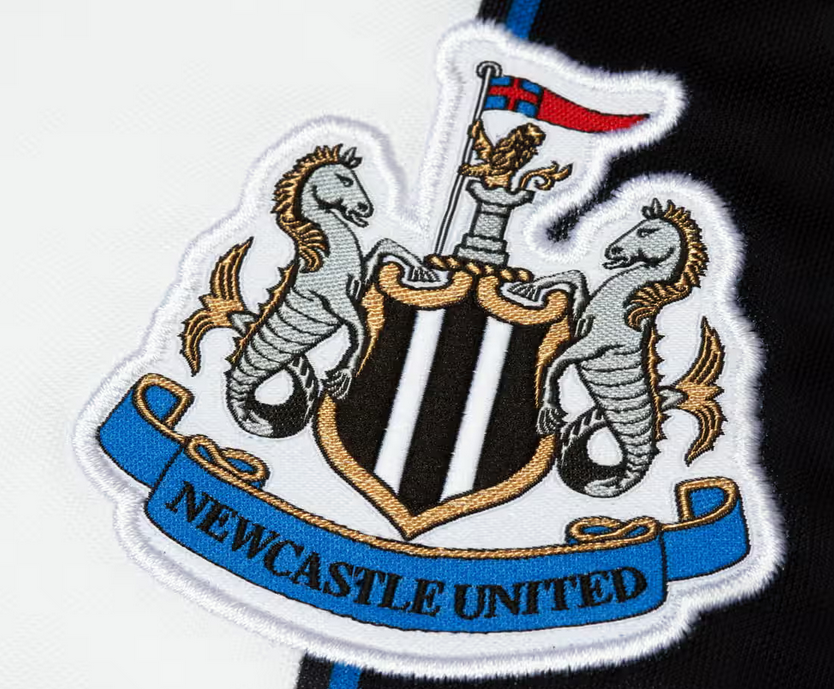Newcastle United have taken a bold step toward modernizing their brand, announcing plans to redesign their iconic club badge for the 2026-27 season. This decision, aimed at aligning the club’s visual identity with the demands of the digital age, marks a significant moment for the Magpies as they strive to expand their global footprint.
Why Newcastle is Redesigning its Crest
The current Newcastle United crest, which dates back to 1988, features the city’s original coat of arms—a design that has become a cherished symbol for generations of supporters. It prominently displays two seahorses flanking a shield, a castle turret topped with a lion, and the flag of St. George, reflecting the city’s rich maritime and defensive history. However, as Newcastle’s global ambitions grow, the club’s leadership believes this intricate design no longer meets the practical needs of modern branding.
In an email to supporters on Friday, club executives explained their rationale for the redesign, stating, “As our club grows on the global stage, the symbol that represents us needs to be able to keep pace. It needs to show up clearly and confidently across everything from kits to screens to merchandise.”
Challenges of the Current Badge
While the current crest holds significant historical and emotional value, it poses practical challenges in the digital era. The complex details that make it a striking piece of heraldic art can be difficult to reproduce clearly and consistently across various digital platforms and physical merchandise. This can lead to inconsistent branding and a lack of visual impact, particularly when the crest is scaled down for mobile screens, social media profiles, and digital broadcasts.
This issue is not unique to Newcastle. Many historic football clubs have grappled with the same dilemma in recent years, opting to simplify their crests to improve legibility and impact in a crowded digital space. Juventus, Inter Milan, and Aston Villa are just a few examples of clubs that have recently modernized their logos to better align with contemporary branding trends.
The Fan Consultation Process
Aware of the deep connection fans have with the current badge, Newcastle’s leadership has emphasized a collaborative approach to the redesign. The club has initiated a week-long consultation process, inviting supporters to share their preferences and feedback before casting their votes on a range of design options. This approach aims to ensure that the final design remains true to the club’s heritage while also meeting modern branding standards.
“It’s time to update our crest,” the club said in their message to fans. “This isn’t a decision we take lightly. We love our crest. It’s iconic and has stood us through unforgettable triumphs and testing times. But it was created in a different era. Its intricate design doesn’t always translate well in today’s digital world.”
Preserving Tradition While Embracing Change
Despite the need for modernization, the club has reassured supporters that radical changes are unlikely. According to the message sent to fans, the club’s preferred approach is to “refine and revive” the existing design rather than overhaul it completely. This means elements like the seahorses and castle turret, which are deeply symbolic of Newcastle’s maritime heritage and fortifications, are expected to remain key components of the new crest.
Moreover, club insiders have indicated that references to Saudi Arabia, the home of Newcastle’s current ownership group, are highly unlikely to be included in the new design, further emphasizing a focus on local heritage rather than external influences.
The Broader Context of Football Branding
Newcastle’s decision to rethink its badge is part of a broader trend in football, where clubs are increasingly viewing their crests as critical assets in building global brand recognition. With football’s reach expanding through digital platforms, clear, adaptable logos have become essential for maintaining a consistent brand identity across diverse media.
This strategic shift is also driven by the financial realities of modern football. Successful rebranding can unlock significant commercial opportunities, from merchandise sales to lucrative sponsorship deals, as clubs seek to engage fans around the world.
Looking Ahead to the Future
As Newcastle prepares to unveil its new crest for the 2026-27 season, the stakes are high. The club must strike a delicate balance between honoring its rich history and embracing the demands of modern branding. If successful, the new design could become a powerful symbol of the club’s ambitions and a unifying emblem for fans around the world.
Ultimately, the outcome of this redesign will depend not just on the final visual design, but also on how effectively the club engages its passionate fan base throughout the process. With fans set to play a critical role in selecting the new crest, Newcastle United’s next chapter promises to be as dynamic and ambitious as the club itself.



